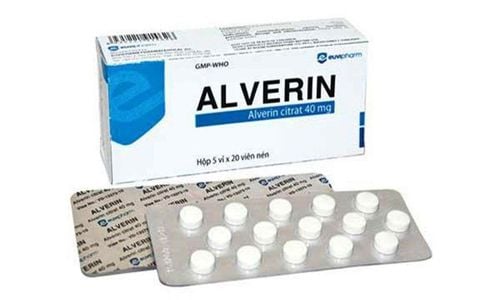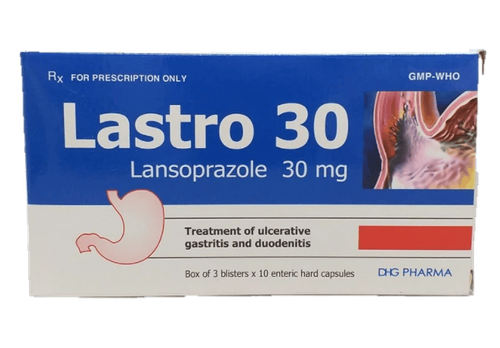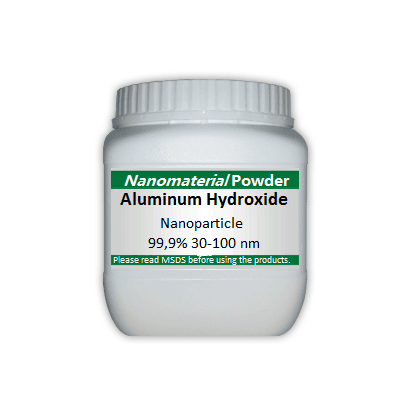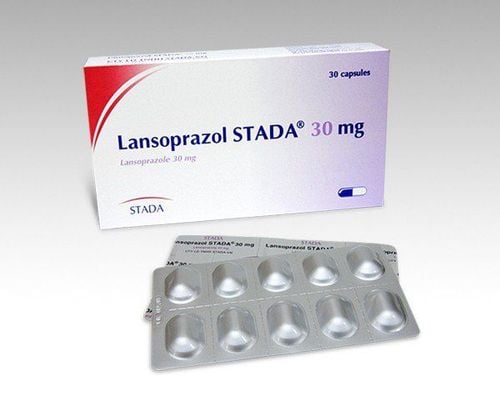This is an automatically translated article.
Currently, the number of people suffering from diseases related to the gastrointestinal tract is increasing, common diseases such as gastroesophageal reflux disease, oesophagitis, gastric ulcer, duodenal ulcer, Zollinger - Ellison syndrome... and Omeraz 20 is the first choice of many patients. For more information about the effects of omeraz 20, as well as how to use omeraz 20, please read more articles below.
1. Uses of omeraz 20
Omeraz 20 has the main ingredient Omeprazole, which belongs to the group of antacids, anti-reflux and anti-ulcer drugs. Prepared in the form of 20mg anti-gastric capsules produced by Boston Pharmaceutical Joint Stock Company.Omeraz 20 is indicated in the following cases:
For adults
Treatment and prevention of recurrent gastric and duodenal ulcers. Used in combination with antibiotics in the treatment of gastric ulcers caused by H.pylori infection. Treatment or prevention of gastric and duodenal ulcers caused by NSAIDs. Treatment of esophagitis with reflux. Symptomatic treatment of gastroesophageal reflux disease. Treatment of gastrin-secreting tumors in the pancreas and duodenum (also known as Zollinger-Ellison syndrome). For children
Children 2 years of age and older and weighing more than 20kg Treat esophagitis with reflux. Symptomatic treatment of gastroesophageal reflux disease (heartburn and acid reflux) For adolescents and children 4 years of age and older
Use in combination with antibiotics to treat stomach ulcers infected with H.pylori .
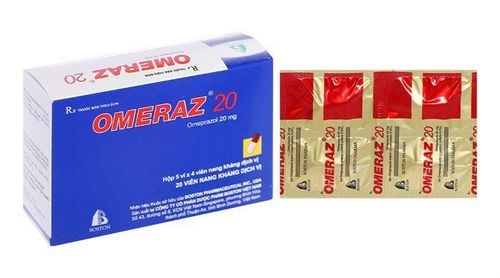
Thuốc Omeraz có tác dụng chống trào ngược và chống loét dạ dày
2. How to take Omeraz 20
2.1. Usage of the drug omeraz 20 Oral administration, the drug should be taken with filtered water. Omeraz 20 is recommended to take in the morning, take the tablet whole, do not chew or crush the tablet. For patients with swallowing problems and children who cannot swallow tablets, the patient can use the following way: The patient can split the capsule and mix the microparticles in about 100 ml of filtered water or use acidic water. such as apple juice, orange juice, and drink immediately. 2.2. Dosage of Omeraz 20 Adults: Treatment of gastric and duodenal ulcers:
As recommended, the usual dose is 20mg x 1 time / day, if necessary can be increased to 40mg x 1 time / day. 2 to 4 weeks is ulcer healing time for duodenal ulcers and 4 to 8 weeks for gastric ulcers.
Prophylaxis of gastric and duodenal ulcer recurrence:
The usual dose is 20 mg x 1 time/day. The dose may be increased to 40 mg once daily in poor responders.
Combination with antibiotics in the treatment of stomach ulcers infected with H.pylori:
The dose of combination with antibiotics in the treatment of H. Pylori eradication of Omeraz 20 is 20mg x 2 times/day. The selection of appropriate antibiotics must be based on the tolerance of each patient, the situation of antibiotic resistance in the area they are in, and the treatment protocol of reputable organizations in the treatment of diseases. this.
Treatment of gastric and duodenal ulcers caused by NSAIDs:
The dose of Omeraz 20 is 20 mg x 1 time / day. Ulcers usually heal within 4 weeks. For patients with poor drug response, recovery time can be up to 8 weeks.
Prophylaxis of gastric - duodenal ulcers caused by NSAIDs:
The dose of Omeraz is 20 mg x 1 time / day.
Treatment of reflux esophagitis:
The recommended dose of Omeraz is 20mg x 1 time/day.
For people with severe esophagitis:
The recommended starting dose is 40mg x 1 time/day. Recovery time is usually 4 weeks for most patients and can be as long as 8 weeks for patients with severe inflammation or poor response.
Symptomatic treatment of gastroesophageal reflux disease:
The usual dose of Omeraz is 20mg x 1 time/day.
In some cases, a lower dose (10 mg once daily) may also provide a good response. If symptoms are not controlled after 4 weeks at 20 mg daily, the patient should be further tested to confirm the diagnosis.
Treatment of Zollinger - Ellison syndrome:
The usual starting dose is 60mg/day. Dosage depends on the patient's condition and continues treatment as long as clinically indicated.
For severe disease and poor response to other regimens, effective treatment can still be achieved and more than 90% of patients are maintained on Omeraz 20 - 120mg daily dose. Doses above 80 mg should be divided into 2 doses/day.
Children Children 2 years of age and older and weighing more than 20kg:
The dose of Omeraz 20 is 20mg x 1 time / day, the dose can be increased up to 40mg x 1 time / day if necessary.
The duration of treatment for reflux esophagitis is from 4 to 8 weeks.
The duration of symptomatic treatment in gastroesophageal reflux disease (heartburn and acid reflux) is 24 weeks. If symptoms are not well controlled within 2 to 4 weeks the patient should undergo further testing to confirm the diagnosis.
Adolescents and children 4 years of age and older:
The dose of Omeraz 20 in combination with antibiotics for the treatment of stomach ulcers infected with H.pylori is 20mg x 1 time / day, the dose of antibiotics should be adjusted. weight-adjusted for each patient.
Omeraz 20 treatment duration: from 1 to 2 weeks.
Patients with renal impairment: use according to the recommended dose. Patients with liver failure: The dose should not exceed 20mg/day. Elderly: if liver function is still normal, no dose adjustment is necessary. Note: The above doses of Omeraz 20 are for reference only. The specific dose depends on the patient's condition and disease progression. You must not buy and use drugs without consulting your doctor.

Người bệnh nên dùng thuốc Omeraz 20 theo hướng dẫn của bác sĩ
3. Precautions when using Omeraz 20
When any alarming symptoms appear (such as noticeable weight loss, recurrent vomiting, dysphagia, vomiting blood or black stools) and when the patient is suspicious or confirmed gastric ulcer, the patient should be examined and the risk of malignancy excluded prior to treatment because omeprazole may cause symptom relief and lead to delay in diagnosis or misdiagnosis. .
Co-administration of Omeraz 20 with atazanavir is not recommended. If a combination of them is required, the patient should be closely monitored clinically, and the dose of atazanavir should be increased to 400 mg and, in combination with ritonavir at 100 mg, the dose of Omeraz 20 should not exceed 20 mg.
Omeraz 20, like other antacids, may reduce the absorption of vitamin B12 (cyanocobalamin) due to lack of gastric acid. When initiating treatment, care should be taken in patients with reduced vitamin B12 stores or risk factors for reduced vitamin B12 absorption when long-term treatment with omeprazole is indicated. Omeprazole is a CYP2C19 inhibitor. The risk of interactions with other drugs via CYP2C19 should be considered when starting or ending treatment with Omeraz 20. Omeprazole may interact with clopidogrel. Although there are no clinical studies yet, as a precaution, the combination of Omeraz 20 and clopidogrel is not recommended.
Prolonged treatment (over 3 months or possibly years) with proton pump inhibitors (PPIs) typically Omeraz 20 can cause severe hypomagnesemia. Severe signs of hypomagnesaemia may occur, such as fatigue, delirium, convulsions, dizziness, muscle spasticity, and ventricular arrhythmias, but symptoms may also be insidious and easy to begin. easily overlooked. In the majority of patients, after starting magnesium replacement therapy and discontinuing PPIs, hypomagnesaemia improved.
For patients requiring prolonged therapy or those taking PPIs concurrently with digoxin or other drugs that may cause hypomagnesaemia (such as diuretics), healthcare professionals should consider quantifying magnesium levels. blood before starting PPI therapy and periodically during treatment.
PPIs, especially when used in high doses and for a long time (>1 year), may slightly increase the risk of hip, wrist, and spine fractures, especially in elderly patients or when they are present. presence of other risk factors. Patients at risk of osteoporosis should be carefully cared for, with adequate vitamin D and calcium supplementation.
PPIs have been associated with very rare cases of subacute lupus erythematosus (SCLE) skin lesions. If damage occurs, especially on sun-exposed skin, and if accompanied by symptoms of joint pain, the patient should immediately seek medical attention. Patients with a history of SCLE with one PP may be at increased risk of SCLE when using other PPIs.
Detection of neuroendocrine tumors may be affected by increased CgA levels. To avoid this effect, treatment with Omeraz 20 should be discontinued at least 5 days before CgA measurement.
Omeraz 20 should be used for the long-term treatment of children with chronic diseases only when clearly needed.
Please dial HOTLINE for more information or register for an appointment HERE. Download MyVinmec app to make appointments faster and to manage your bookings easily.




